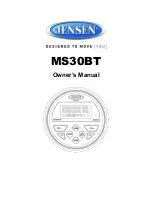
Call Forward Outside System
The Call Forward Outside System (CFOS) feature allows the system to forward incoming or transferred line calls to
telephone numbers that are outside the system. The CFOS feature forwards calls over any available outbound lines
or line groups and does not use any conference circuits. Since CFOS involves outbound calls, those calls are subject
to all line access, toll restriction, and automatic route selection restrictions normally imposed on the users. Any calls
that CFOS can not service (no outbound line available, toll restricted, and so forth), ring the system as normal calls.
Note also that CFOS will not forward calls associated with group intercoms and hunt groups. The CFOS feature is
useful for after-hours forwarding of business calls to alternate sites such as a home or cellular telephone. To help
system managers keep account of CFOS activity , the system marks CFOS calls with an
F
in the SMDA records
printout.
Users activate or deactivate CFOS by dialing a feature code, pressing a preprogrammed button or pressing an
interactive button on an LCD speakerphone. Once users activate CFOS, they select the outbound line or line group in
any of the normal line selections methods available to them. They also designate the forward destination by dialing
the number or pressing a speed dial button. (If users do not make a line and destination choice, the system uses the
most recently used selections.) DISA callers can activate and deactivate CFOS remotely. When DISA callers activate
CFOS, they receive several quick tone bursts and the system awaits any program changes. When they deactivate
CFOS, the system returns dial tone. After they gain access to the system, they can dial the CFOS code, dial an
outbound line or line group selection, and dial the destination number. Once a user activates CFOS, it remains active
and neither system resets nor power outages will deactivate it. After activation, incoming or transferred calls to an
idle CFOS-enabled station forward outside the system to the CFOS destination over the selected outbound line or
line group. CFOS-forwarded calls are subject to the line-to-line disconnect timer action. If time-out occurs, the
system alerts the system operator. He or she can join the call as a conference member.
Before CFOS can occur for calls on incoming lines, programmers must enable those lines for CFOS capability.
Before a CFOS-enabled station can forward a call outside the system, the system must be able to associate the call
receiving line with the station.
•
Programmers can take action to associate a CFOS-enabled line with an individual CFOS-enabled station. With
this arrangement, this station is the only one that can forward to an outside destination for a call received on that
line.
•
At sites served by DID line blocks, programmers must enable those lines for CFOS capability but they do not
associate the individual lines with specific CFOS-enabled stations. The system uses the DID translated station
extension to check for the station’s CFOS forwarding ability.
•
When another station transfers a call to a CFOS-enabled station, the feature does not require a line association
with the CFOS-enabled station for it to forward the transferred call outside the system. In this case, the system
identifies the CFOS-enabled station before it makes the transfer.
In addition to the line programming action discussed previously, programmers enable CFOS system-wide with a
system programming choice. They then enable the feature in both station class of service and individual station
programming, and may map a CFOS button on the applicable telephones. When mapping the button, programmers
can also select a destination number; however, any user selected destination number overrides this selection.
Comdial has taken reasonable steps in the design of all product features, including CFOS, which protect against
unauthorized or fraudulent access to, or use of, a system, or which protect against unauthorized, fraudulent or
unaccounted-for access to, or use of, long distance lines. However, no system is entirely invulnerable or immune
from unauthorized or fraudulent access or use, or unaccounted-for access or use, and therefore Comdial disclaims
any and all liability, and makes no warranty, express or implied, relating to unauthorized or fraudulent access or use,
or unaccounted-for access or use.
NOTES:
(1) CFOS will not work on loop start lines without disconnect supervision.
(2) Calls forwarded through CFOS may experience lower audio levels due to the normal line resistance of CO
lines. Low audio level is usually only noticeable on long line loops. If signal loss is a problem at a particular
site, the installer may need to add a line amplifier (repeater) in the lines.
GCA40–130
DXP Plus General Description
58 – Understanding The Features
Содержание DXP Plus Series
Страница 1: ...Digital Communications System R ...
Страница 363: ...Automatic Call Distributor Technical Manual R QuickQ DXP ...
Страница 424: ...Automatic Call Distributor System Manager s Guide R QuickQ DXP ...
Страница 500: ...Wrap up Time 1 6 Wrapping Up A Call 4 3 Z Zoom Box A 2 GCA70 271 Index I 3 ...
Страница 628: ...Interconnecting The VMI X Installing And Programming For ExecuMail IMI89 206 Installing And Programming For ExecuMail 5 ...
Страница 677: ...Connecting The Equipment Installing And Programming The OPX X IMI89 209 Installing The OPX X 7 ...
Страница 728: ...DP I I I I and FX Series Digital Communications Systems Understanding The Visual Man Machine Interface COMDlA ...
Страница 1112: ...9 08 8 90 1 13 4 78 3 94 UNIS029 TAB003 PLS page 6 GCA40 130 DXP Plus General Description 11B Telephone Features ...
















































